Renewable Energy Investments Demonstrate Resilience
Key Takeaways:
- Existing renewable energy transactions with guaranteed fixed prices should not be impacted by the pandemic. Transactions without subsidies, but with a power purchase agreement, should not be affected either.
- Governments and regional authorities are likely to continue to strongly back the renewable energy sector. Many, including the European Union, still have ambitious targets in place
- Future investment in the sector depends on trust in the sustainability of projects and, in particular, on ESG labelling. Investor demand is also growing for tailoring of infrastructure investments.
This crisis is markedly different from previous ones because of the self-imposed lockdowns in nearly all of the world’s economies, which have severely restricted economic activity.
This means only infrastructure that is truly essential to everyday living will outperform. There is an argument to make that renewable energy falls squarely into the “essential” category and, as such, will prove highly resilient in this unusual and unpredictable crisis.
The impact of lockdowns on infrastructure
Infrastructure has, not been immune to the consequences of pandemic lockdowns in countries around the world. There are three main consequences for infrastructure of these lockdowns.
First, there was a decrease in the number of transactions in the primary infrastructure market of about 30% by volume over the first three quarters of 2020, compared to the same period in 2019. The volume of infrastructure debt is also down, but to a lesser extent – about 7%. The fall in volume would have been greater, but for a number of jumbo infrastructure deals completed in Q2. The decrease in volumes was seen mainly in Asia and Europe in Q1 2020 and touched North America in Q2. All regions recorded a low Q3, down about 34% compared to last year in terms of transactions and volume of debt.
The second consequence was a widening in spreads, especially on transactions where the infrastructure asset relies on traffic volumes.
Third, there has been a spate of ratings downgrades. According to Fitch, the ratings agency, the number of infrastructure downgrades in the first half of 2020 more than tripled the number recorded in the whole of 2019. Most downgrades were in transportation. On the positive side, there have been no defaults to date.
Renewable sector flexes its muscles
The lockdown measures have had an impact on renewable energy infrastructure. As in other infrastructure sub-sectors, there have been some construction delays. According to the wind power association WindEurope, delays in constructing new renewable energy plants are expected due to under-capacity in factories and workshops.
But there are reasons to believe that renewable infrastructure will emerge in a strong position in a post-pandemic world. Existing renewable transactions with guaranteed fixed prices should not be impacted by the crisis as they benefit from priority dispatch on the network and a fixed-purchase price or a contract for difference. These transactions should be immune as long the provider is paid the difference between the market price and the set rate.
The few existing transactions without subsidies, but with a power purchase agreement, should not be impacted as long as the corporates can pay for the agreements.
In addition, governments and regional authorities are likely to continue to strongly back the sector. Many, including the European Union, still have ambitious targets in place. “We believe that the European Green deal, which aims to make Europe climate neutral by 2050, will be strengthened by this crisis,” says Celine Tercier, Head of Infrastructure Debt at Natixis Investment Managers. “There is an increasing push to improve the share of renewable energy, energy independence, and European interconnectivity.”
Meanwhile, the German government has moved to ensure its energy mix consists of 65% renewable energy by 2030. During the Covid-19 slowdown Germany saw the nation’s share of renewables reach 60%, up 12% from a year ago (for the period March 10 to April 10 2020). Coal generation fell by 44% over the same period, according to Wartsila data.
Many other countries have announced or strengthened green measures during lockdown periods, including China, which included green incentives in its recent stimulus packages.
Infrastructure debt is a safer place
The resilience of infrastructure investing is enhanced if the investment is made through debt instruments, which are less correlated to economic activity than equity investments. If the debt instrument used is senior secured debt, then the protection is at its strongest; investors in senior secured loans have first call on the asset if something goes wrong. And with pure infrastructure project finance, as long as the covenants and agreements have been properly structured, the protections are far stronger than for corporate bonds.
Default rates in infrastructure debt are extremely low, averaging just 0.56% a year since 2005 and suffering no spikes during the the different crisis.
The recovery rate by infrastructure debt managers at Natixis Investment Managers International Private Debt is 100% over two decades. “We select transactions with strong covenants to control and protect our investment,” says Tercier. “If there is a problem, we have a strong security package, such as a pledge of the borrower’s shares, contracts or even its bank accounts, to solve it.”
Slowdown has bolstered reputation of renewables
Interestingly, the slowdown in economic activity and the subsequent reduction in energy demand, could have a dramatic and positive effect on the reputation of the renewables sector. The International Energy Agency expects Covid-19 to result in the biggest decline in electricity consumption since the great depression. Electricity prices were down from roughly 40€/MWh before the lockdown, to less than 20€/MWh in March, and to just 10€/MWh in April.
During the period of reduced activity, the proportion of Europe’s renewables-based electricity in the power network dramatically increased, with supply outstripping demand at times. Coal-fired power generation was temporarily shut down in countries such as Germany, Spain and the United Kingdom. The technology group Wartsila estimates that the share of renewable energy reached 43% across Europe, an increase of 7% compared to 2019.
In other words, the European Grid has demonstrated its ability to operate with a high share of renewable energy. This has raised the profile of renewables among investors and policymakers, and is likely to give impetus to new investments to reinforce the European grid in any future high-demand environment.
Investors seek reassurance of ESG labelling
Future investment in the renewables sector depends to some extent on asset owners’ trust in the sustainability of projects. In particular, many asset owners now demand to see robust ESG accreditation before they will invest in infrastructure assets.
In Europe, ESG labels include the French SRI and Greenfin Labels, Belgium’s Towards Sustainability, Luxembourg’s LuxFlag, the Nordics’ Nordic Swan Ecolabel, Austria’s Umweltzeichen, Germany and Switzerland’s FNG-Siegel. These seven labels alone accounted for more than €300bn of assets under management (at March 2020). Assets under these labels will more than treble each year at current take-up rates1.
Let’s have a look at the French Greenfin label.Greenfin was created by the French Ministry for Ecological Transition, and provides a guarantee to investors that the financial products bearing the label genuinely contribute to ecological and energy transition. The label is based on four specific criteria: calculation of the share of green investment in a portfolio, formal exclusions of certain activities, consideration of ESG criteria and measurement of the positive impact of the investments.
“We chose this Greenfin label partly because it is really focused on energy transition,” says Tercier. “We made the decision a long time ago to focus on energy transition because it’s a theme in which we think there is good value in terms of stability, resilience and return potential.”
“Even though ESG integration has long been part of our investment process, we realised it was important for investors to have this kind of label because it gives them the transparency they need in terms of the quality of our ESG integration, on the sectors we invest in, and on the quality of reporting on ESG impacts.”
Investors can now pick and choose
Another key, and growing, investor demand is for tailoring of infrastructure investments. As the renewables sector grows and the asset class becomes deeper and more diversified, so investors seek assets which suit their specific needs.
Needs vary by type of investor, by geographic region or by specific ESG requirements. “The depth of the asset class allows us to offer a range of options to investors,” says Tercier. “We can tailor portfolios by duration, sector, currency, hedging and rating (IG/Non IG), ranking (senior/mezzanine) return types (floating or fixed).”
Sometimes, a specific investor need can be negotiated with the borrower. Investors in Asia, for instance, sometimes seek shorter durations. So while the maturity of renewable energy deals can be 20 years or more, it is possible to reduce portfolio duration to around five years, depending on the assets and the borrowers. Short duration projects might include brownfield transactions: refinancing or acquisition (involving a change of equity sponsor) or mezzanine.
Likewise, insurance life companies have longer-term liabilities which need to be matched, so longer duration debt may suit them better. Longer duration projects include public-private partnership (PPP) deals, which typically involve a state entity commissioning the building and running of critical and large-scale infrastructure. The duration may be 25 years or more for PPP assets.
Some investors seek the exclusion of sectors, most commonly oil and gas. Or they wish to exclude sectors which they regard as cyclical, such as those which carry traffic risk. Others still are looking for minimum rating projects, with their threshold perhaps at investment grade. Or they wish to take more risk in sectors they are confident about, and seek only senior non-investment grade debt even mezzanine tranches.
Conclusion: renewables come of age as essential assets
The recent prominence of renewables in the energy mix is indicative of the fact that renewable energy has become essential to the functioning of economies. This is being recognised by policymakers and investors alike.
So, despite the effects of the pandemic, investment in and returns from renewables is unlikely to be knocked off course. If anything, the case for them has been strengthened.
Many investors see the opportunities ahead. As energy and transport are the biggest contributors to CO2 emissions (69% of total CO2 fuel combustion), it is likely that renewable energy, green mobility and energy-efficient building will offer sizeable opportunities for investors.
In allocating increasing proportions of their portfolios to renewable infrastructure, investors expect evidence of a robust ESG process and, increasingly, access to assets which match their risk and return expectations.
Published in February 2021.
Natixis Investment Managers International
French Public Limited liability company with board of Directors (Société Anonyme).
Share capital : €51 371 060,28. RCS Paris : 329 450 738.
Regulated by the Autorité des Marchés Financiers (AMF) under no. GP 90-009. 43 avenue Pierre Mendès France 75013 Paris.
www.im.natixis.com
Natixis Investment Managers
RCS Paris 453 952 681
Share Capital: €178 251 690
43 avenue Pierre Mendès France
75013 Paris
www.im.natixis.com
This communication is for information only and is intended for investment service providers or other Professional Clients. The analyses and opinions referenced herein represent the subjective views of the author as referenced unless stated otherwise and are subject to change. There can be no assurance that developments will transpire as may be forecasted in this material.
Copyright © 2021 Natixis Investment Managers S.A. – All rights reserved





 COVID-19: What is the Impact on Infrastructure Debt Worldwide?
COVID-19: What is the Impact on Infrastructure Debt Worldwide?
 Secure Income and Green Infrastructure: An Unlikely Marriage?
Secure Income and Green Infrastructure: An Unlikely Marriage?

 Infrastructure Debt: Where is the Value for Investors?
Infrastructure Debt: Where is the Value for Investors?